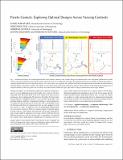| dc.contributor.author | Makatura, Liane | |
| dc.contributor.author | Guo, Minghao | |
| dc.contributor.author | Schulz, Adriana | |
| dc.contributor.author | Solomon, Justin | |
| dc.contributor.author | Matusik, Wojciech | |
| dc.date.accessioned | 2021-10-27T20:03:59Z | |
| dc.date.available | 2021-10-27T20:03:59Z | |
| dc.date.issued | 2021-08 | |
| dc.identifier.uri | https://hdl.handle.net/1721.1/134209 | |
| dc.description.abstract | <jats:p>
Manufactured parts are meticulously engineered to perform well with respect to several conflicting metrics, like weight, stress, and cost. The best achievable trade-offs reside on the
<jats:italic>Pareto front</jats:italic>
, which can be discovered via performance-driven optimization. The objectives that define this Pareto front often incorporate assumptions about the
<jats:italic>context</jats:italic>
in which a part will be used, including loading conditions, environmental influences, material properties, or regions that must be preserved to interface with a surrounding assembly. Existing multi-objective optimization tools are only equipped to study one context at a time, so engineers must run independent optimizations for each context of interest. However, engineered parts frequently appear in many contexts: wind turbines must perform well in many wind speeds, and a bracket might be optimized several times with its bolt-holes fixed in different locations on each run. In this paper, we formulate a framework for variable-context multi-objective optimization. We introduce the
<jats:italic>Pareto gamut</jats:italic>
, which captures Pareto fronts over a range of contexts. We develop a global/local optimization algorithm to discover the Pareto gamut directly, rather than discovering a single fixed-context "slice" at a time. To validate our method, we adapt existing multi-objective optimization benchmarks to contextual scenarios. We also demonstrate the practical utility of Pareto gamut exploration for several engineering design problems.
</jats:p> | |
| dc.language.iso | en | |
| dc.publisher | Association for Computing Machinery (ACM) | |
| dc.relation.isversionof | 10.1145/3450626.3459750 | |
| dc.rights | Creative Commons Attribution 4.0 International license | |
| dc.rights.uri | https://creativecommons.org/licenses/by/4.0/ | |
| dc.source | ACM | |
| dc.title | Pareto gamuts | |
| dc.type | Article | |
| dc.contributor.department | Massachusetts Institute of Technology. Department of Electrical Engineering and Computer Science | |
| dc.contributor.department | Massachusetts Institute of Technology. Computer Science and Artificial Intelligence Laboratory | |
| dc.contributor.department | Massachusetts Institute of Technology. Center for Computational Science and Engineering | |
| dc.relation.journal | ACM Transactions on Graphics | |
| dc.eprint.version | Final published version | |
| dc.type.uri | http://purl.org/eprint/type/JournalArticle | |
| eprint.status | http://purl.org/eprint/status/PeerReviewed | |
| dc.date.updated | 2021-09-27T15:17:33Z | |
| dspace.orderedauthors | Makatura, L; Guo, M; Schulz, A; Solomon, J; Matusik, W | |
| dspace.date.submission | 2021-09-27T15:17:42Z | |
| mit.journal.volume | 40 | |
| mit.journal.issue | 4 | |
| mit.license | PUBLISHER_CC | |
| mit.metadata.status | Authority Work and Publication Information Needed | |
